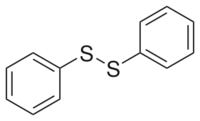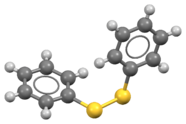Chemistry:Diphenyl disulfide

| |
| Names | |
|---|---|
| Preferred IUPAC name
1,1′-Disulfanediyldibenzene | |
| Other names
Disulfanyldibenzene
Diphenyl disulfide Phenyl disulfide 1,2-Diphenyldisulfane (not recommended) | |
| Identifiers | |
3D model (JSmol)
|
|
| ChEBI | |
| ChEMBL | |
| ChemSpider | |
| EC Number |
|
PubChem CID
|
|
| RTECS number |
|
| UNII | |
| |
| |
| Properties | |
| C12H10S2 | |
| Molar mass | 218.33 g·mol−1 |
| Appearance | Colorless crystals |
| Melting point | 61 to 62 °C (142 to 144 °F; 334 to 335 K) |
| Insoluble | |
| Solubility in other solvents | Soluble in diethyl ether, benzene, carbon disulfide, and THF |
| Structure | |
| 0 D | |
| Hazards | |
| Main hazards | Flammable |
| GHS pictograms | 
|
| GHS Signal word | Warning |
| H315, H319, H335 | |
| P261, P264, P271, P273, P280, P302+352, P304+340, P305+351+338, P312, P321, P332+313, P337+313, P362, P391, P403+233, P405, P501 | |
| Related compounds | |
Related compounds
|
Thiophenol, Dimethyl disulfide, Diphenyl diselenide |
Except where otherwise noted, data are given for materials in their standard state (at 25 °C [77 °F], 100 kPa). | |
| Infobox references | |
Diphenyl disulfide is the chemical compound with the formula (C6H5S)2. This colorless crystalline material is often abbreviated Ph2S2. It is one of the more commonly encountered organic disulfides in organic synthesis. Minor contamination by thiophenol is responsible for the disagreeable odour associated with this compound.
Preparation and structure
Diphenyl disulfide is usually prepared by the oxidation of thiophenol:
- 2 PhSH + I2 → Ph2S2 + 2 HI
Hydrogen peroxide can also be used as the oxidant.[2] Ph2S2 is rarely prepared in the laboratory because it is inexpensive, and the precursor has a disagreeable odour.
Like most organic disulfides, the C–S–S–C core of Ph2S2 is non-planar with a dihedral angle approaching 85°.[3]
Reactions
Ph2S2 is mainly used in organic synthesis as a source of the PhS substituent.[4] A typical reaction entails the formation of PhS-substituted carbonyl compounds via the enolate:
- RC(O)CHLiR' + Ph2S2 → RC(O)CH(SPh)R' + LiSPh
Reduction
Ph2S2 undergoes reduction, a reaction characteristic of disulfides:
- Ph2S2 + 2 M → 2 MSPh (M = Li, Na, K)
Hydride reagents such as sodium borohydride and super hydride can also be used as reductants. The salts PhSM are sources of the potent nucleophile PhS−. Most alkyl halides, RX (X = halide) convert it to the thioethers with the general formula RSPh. Analogously, protonation of MSPh gives thiophenol:
- PhSM + HCl → HSPh + MCl
Halogenation
Ph2S2 reacts with chlorine to give phenylsulfenyl chloride PhSCl (Zincke disulfide cleavage). This species is usually generated and used in situ. With xenon difluoride, Ph2S2 reacts to give phenylsulfur pentafluoride.[5]
Catalyst for photoisomerization of alkenes
Ph2S2 catalyzes the cis-trans isomerization of alkenes under UV-irradiation.[6]
Oxidation
Oxidation of Ph2S2 with lead(IV) acetate (Pb(OAc)4) in methanol affords the sulfinite ester PhS(O)OMe.[7]
References
- ↑ "Diphenyl disulfide" (in en). https://pubchem.ncbi.nlm.nih.gov/compound/13436#section=Safety-and-Hazards.
- ↑ Ravikumar,K. S.; Kesavan, V.; Crousse, B.; Bonnet-Delpon, D.; Bégué, J.-P. (2003). "Mild and Selective Oxidation of Sulfur Compounds in Trifluoroethanol: Diphenyl Disulfide and Methyl Phenyl Sulfoxide". Organic Syntheses 80: 184. http://www.orgsyn.org/demo.aspx?prep=v80p0184.
- ↑ T.Shimizu; H.Isono; M.Yasui; F. Iwasaki; N. Kamigata (2001). "Solid State Optical Activity of Dichalcogenides: Isolation by Chiral Crystallization and Determination of Absolute Configuration". Org. Lett. 3 (23): 3639–3641. doi:10.1021/ol010172g. PMID 11700101.
- ↑ Byers, J. H. (2004). "Diphenyl Disulfide". in J. Wiley & Sons. Encyclopedia of Reagents for Organic Synthesis (Ed: L. Paquette). New York. doi:10.1002/047084289X. ISBN 9780471936237..
- ↑ Sergeeva, Tatiana A.; Dolbier, William R. (2004-07-01). "A New Synthesis of Pentafluorosulfanylbenzene" (in en). Organic Letters 6 (14): 2417–2419. doi:10.1021/ol0491991. ISSN 1523-7060. PMID 15228293. https://pubs.acs.org/doi/10.1021/ol0491991.
- ↑ Thalmann, A. Oertle, K.; Gerlach, H. (1990). "Ricinelaidic Acid Lactone". Organic Syntheses. http://www.orgsyn.org/demo.aspx?prep=cv7p0470.; Collective Volume, 7, pp. 470
- ↑ Field, L.; Locke, J. M. (1973). "Methyl Benzenesulfinate". Organic Syntheses. http://www.orgsyn.org/demo.aspx?prep=cv5p0723.; Collective Volume, 5, pp. 723
 |


